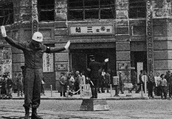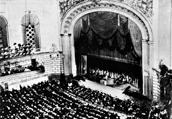HOME > Reconstruction of Japan : Outline
Outline
- a. End of the War and Allied Occupation
- b. Rebuilding Political Parties and General Election
- c. The GHQ and Postwar Reform
- d. Shift in Occupation Policies and Recovery of Independence

Policeman and MP control trafic at the intersection of Ginza 4chome, 1946 (Showa 21). From "Tsukon no Showa. Graphic Report"
Japan accepted the terms of the Potsdam Declaration on 15 August 1945 (Showa 20), that ended Pacific War.Japan then was placed under the occupation of the Allied Powers, led by the United States. Thereafter, the General Headquarters, Supreme Commander for the Allied Powers (GHQ/SCAP) issued directives to the Japanese Government, implementing various reforms based on the major policies of demilitarization and democratization.
Historical materials and Description
 5-1YOSHIDA's Sense of Relief on the War's End
5-1YOSHIDA's Sense of Relief on the War's End
- Letter from YOSHIDA Shigeru to KURUSU Saburo
 5-2Responsibility for the War
5-2Responsibility for the War
- Interpellation on Measures to be Taken by the Government to Clarify the Causes Leading the Unfavorable End of the Great East Asian War and Assessing Responsibility
- Reflections on the Government's Defense of Its Position
 5-3The Occupation and the Beginning of Reform
5-3The Occupation and the Beginning of Reform
- U.S. Initial Post-Surrender Policy for Japan (SWNCC150/4/A)
- Memorandum for: Imperial Japanese Government. Through: Central Liaison Office, Tokyo. Subject: Removal of Restrictions on Political, Civil, and Religious Liberties.(SCAPIN-93)
With Japan's defeat in the war, the political parties, which had suspended party activities during the war, reemerged, and they resumed their active rolls. The Japan Socialist Party, the Japan Liberal Party, the Japan Progressive Party, and the Japan Cooperative Party were formed one after the others, and the Japan Communist Party was legalized. Japan's initial postwar election held in April 1946 (Showa 21), saw women exercise their franchise for the first time. Thirty Nine were elected as well as many other freshmen Diet members. The Japan Liberal Party emerged as the leading party.
Historical materials and Description
 5-4Reconstruction of the Political Parties
5-4Reconstruction of the Political Parties
- Record of Preparation for the Formation of the New Japan Liberal Party
- Akahata, Vol. 1
- Declaration
- Platform of the Japan Progressive Party
- Political Parties in Japan
- Political Parties in Japan: Developments during the Week Ending 17 November 1945
 5-5General Elections
5-5General Elections
- Poster from the First Postwar General Election
- House of Councillors Candidate Poster
- Draft of Election Campaign Speech
- Recommendation Letter
The SHIDEHARA Cabinet had pursued the task of constitutional reform right after the war, but, the eventual Government proposal for a new Constitution followed the outlines of the draft drawn up by GHQ. The Diet then conducted its deliberations based on it. The new Constitution of Japan was promulgated on 3 November 1946 (Showa 21), resting on the principles of popular sovereignty and pacifism. At the sametime, directives from GHQ led to other wide ranging political and economic reforms, such as the purge of "undesirables" from public office, land reform, and the dissolution of the zaibatsu. The Japan Socialist Party became the ruling party in the general election of April 1947 (Showa 22), and its leader, KATAYAMA Tetsu, assumed the post of Prime Minister in a three party coalition Cabinet.
Historical materials and Description
 5-6Constitutional Reform (The MATSUMOTO Committee)
5-6Constitutional Reform (The MATSUMOTO Committee)
- Outline of Constitutional Reform
- Constitution of Japan (GHQ Draft)
- Outline of a Draft for a Revised Constitution
 5-7Purge of Undesirables from Public Office
5-7Purge of Undesirables from Public Office
- Memorandum for: Imperial Japanese Government. Through: Central Liaison Office, Tokyo. Subject: Removal and Exclusion of Undesirable Personnel from Public Office
- "The Showa 21 Diary"
 5-8Economic Reconstruction
5-8Economic Reconstruction
- Memorandum for: Imperial Japanese Government. Through: Central Liaison Office, Tokyo. Subject: Elimination of War Profits and Reorganization of National Finance
- On the Investigation into My Qualifications
- Letter of Resignation
 5-9Formation of the Socialist Party Cabinet
5-9Formation of the Socialist Party Cabinet
- Letter of YOSHIDA Shigeru to MAKINO Nobuaki
- [General MacArthur's Statement]

The opening ceremony of the Japan Peace Treaty Conference, held in the San Francisco Opera House, September 4, 1951 (Showa 26) From "Yoshida Naikaku"
The labor movement in Japan became quite powerful as a result of the occupation's democratization policies. The intensification of the Cold War between the United States and the Soviet Union, however, saw a shift of Occupation policies, including the end of the purge on "undesirables" from public office, and an increasing crackdown on leftists. General Douglas MACARTHUR directed Prime Minister YOSHIDA Shigeru to establish a National Police Reserve after the outbreak of the Korean War in June 1950 (Showa 25). In September 1951, the San Francisco Peace Treaty was concluded, along with the U.S.-Japan Security Treaty. Japan's place in the international community as an independent nation was restored in April 1952 following the treaty's ratification.
Historical materials and Description
 5-10Shift in Occupation Policy
5-10Shift in Occupation Policy
- Recommendations with Respect to U.S.Policy toward Japan (NSC13/2)
 5-11Labor Movement
5-11Labor Movement
- Why Object to Being Fired?
- "Documents Related to the Inaugural Rally of the General Council of Trade Unions of Japan: Statement of Purposes, Inaugural Rally"
 5-12The Red Purge
5-12The Red Purge
- [Douglas MacArthur's Letter to Prime Minister]
 5-13Creation of a National Police Reserve
5-13Creation of a National Police Reserve
- Reflections on the Police Reserve
- [Douglas MacArthur's Letter to Prime Minister]
 5-14Peace Treaty and the U.S.-Japan Security Treaty
5-14Peace Treaty and the U.S.-Japan Security Treaty
- The Decision on the Stance to Take toward Both the Peace and Security Treaties